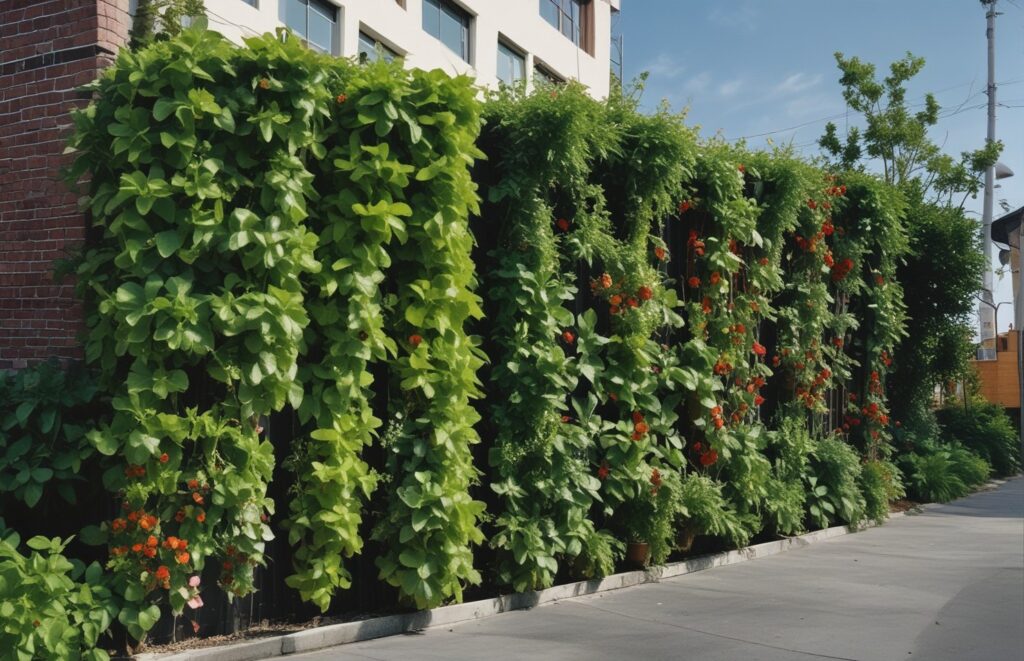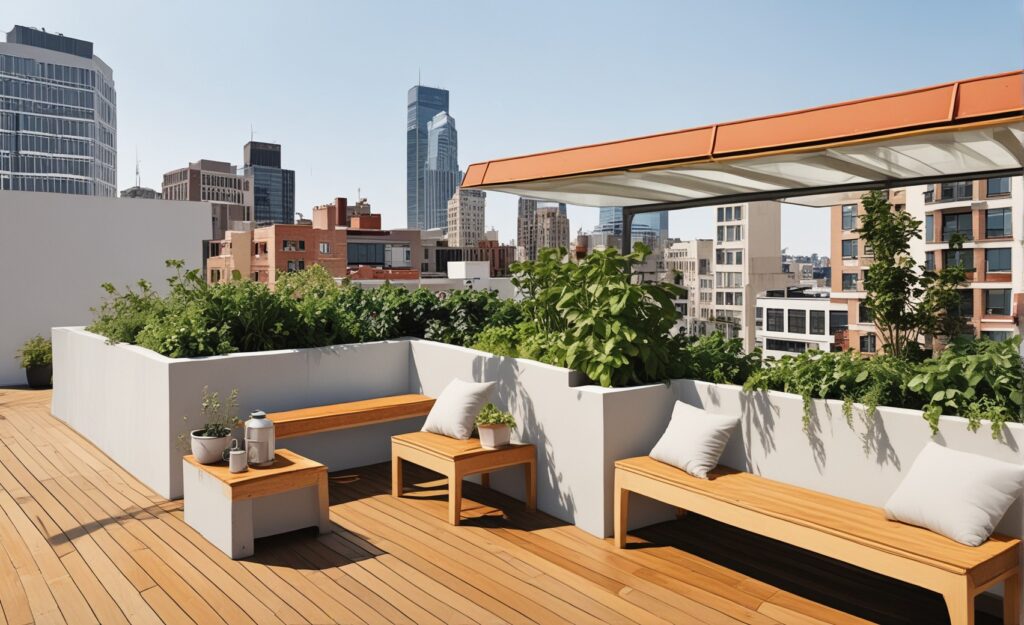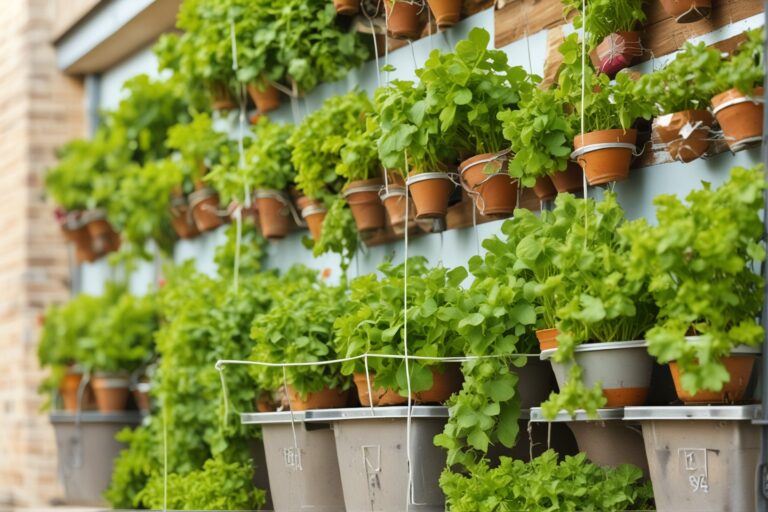As urbanization continues to rise, the charm of nature often seems to vanish behind towering buildings and busy streets. However, urban gardening is an innovative solution that allows city dwellers to cultivate greenery, grow their own food, and create peaceful havens amidst the hustle and bustle of urban life. This article explores various methods, benefits, and ideas for urban gardening, specifically tailored for small spaces.
Key Takeaways
- Urban gardening enhances quality of life by providing fresh produce and improving mental well-being.
- Techniques like container gardening, vertical gardening, and hydroponics maximize limited space.
- Sustainable practices, community involvement, and thoughtful plant choices are crucial for successful urban gardening.
Understanding Urban Gardening

Urban gardening involves cultivating, processing, and distributing food within city environments. Unlike traditional farming, urban gardening is highly adaptable, allowing for various formats based on available space. Whether it’s a balcony, rooftop, or a small patch of land, urban gardening offers solutions that can fit any environment.
Benefits of Urban Gardening
- Food Security: With rising food prices and concerns about food safety, growing your own produce offers a reliable source of fresh fruits and vegetables.
- Environmental Impact: Urban gardens contribute to biodiversity, reduce the urban heat island effect, and improve air quality.
- Mental Health: Gardening has therapeutic benefits, reducing stress and promoting mindfulness through hands-on interaction with nature.
- Community Engagement: Community gardens foster social interaction, bringing people together to share resources and knowledge.
Types of Urban Gardens
1. Container Gardening

Container gardening is an excellent option for urban dwellers with limited space. It involves planting in pots, window boxes, or other containers that can be placed almost anywhere. This method is highly flexible, allowing for easy mobility and customization.
Benefits of Container Gardening
- Versatility: Containers can be arranged in various configurations and can be moved according to sunlight and aesthetic preference.
- Soil Control: You have complete control over the soil quality, allowing you to create the perfect growing medium for your plants.
- Accessibility: Ideal for those with limited mobility; elevated containers reduce bending and provide easy access.
Best Practices for Container Gardening
- Choose the Right Containers: Select pots with drainage holes to prevent water accumulation, which can lead to root rot.
- Use Quality Soil: Opt for a high-quality potting mix that retains moisture while providing adequate drainage.
2. Vertical Gardening

Vertical gardening is a creative way to maximize space by growing plants upward instead of outward. This technique can transform any wall or fence into a lush garden, allowing for a variety of plants to thrive in a small footprint.
Benefits of Vertical Gardening
- Space Efficiency: Ideal for urban settings where horizontal space is limited, allowing for a greater number of plants.
- Aesthetic Appeal: Vertical gardens can create stunning visual displays, enhancing the beauty of urban environments.
- Improved Airflow: Better air circulation can reduce the risk of diseases that often affect densely planted areas.
Best Practices for Vertical Gardening
- Support Structures: Use trellises, wall-mounted planters, or hanging pots to support climbing plants.
- Choose the Right Plants: Select suitable climbing plants like peas, beans, cucumbers, and flowering vines that can thrive in vertical spaces.
3. Rooftop Gardens

Rooftop gardens are an excellent way to utilize unused flat roofs in urban environments. These gardens can provide fresh produce while offering insulation benefits for the building.
Benefits of Rooftop Gardens
- Temperature Regulation: Rooftop gardens can help lower indoor temperatures, reducing cooling costs during the summer.
- Biodiversity: These green spaces can support various species of plants and wildlife, contributing to urban biodiversity.
- Aesthetic Enhancement: Rooftop gardens offer stunning views and can beautify the skyline.
Best Practices for Rooftop Gardens
- Weight Considerations: Ensure that the building can support the weight of the garden, including soil, plants, and water.
- Choose Appropriate Plants: Consider lightweight plants that thrive in containers and can tolerate wind and exposure, such as herbs, succulents, and certain vegetables.
4. Hydroponics and Aquaponics

Hydroponics involves growing plants in a nutrient-rich water solution without soil, while aquaponics combines this with aquaculture, raising fish alongside plants. Both methods are highly efficient for urban gardening.
Benefits of Hydroponics and Aquaponics
- Space Saving: These systems can be set up indoors or on small patios, making them ideal for urban living.
- Faster Growth: Plants often grow faster in hydroponic systems due to better access to nutrients and water.
- Water Efficiency: These systems use significantly less water compared to traditional soil-based gardening.
Best Practices for Hydroponics and Aquaponics
- System Selection: Research different hydroponic systems such as nutrient film technique (NFT) or deep water culture (DWC) to find one that fits your needs.
- Nutrient Management: Regularly check and adjust nutrient levels and pH to maintain optimal conditions for plant growth.
Selecting the Right Location
Finding the right spot for your urban garden is crucial to its success. Here are key factors to consider:
Sunlight Availability
Most vegetables and herbs require at least 6-8 hours of direct sunlight daily. Observe your potential gardening area throughout the day to assess sunlight patterns.
- For Sunny Spaces: Consider planting tomatoes, peppers, and herbs like basil that thrive in full sun.
- For Shaded Areas: If your space receives less sunlight, opt for shade-tolerant plants such as lettuce, spinach, and certain herbs.
Accessibility
Ensure that your garden is easily accessible for maintenance. If it’s hard to reach, it may lead to neglect. Containers can be placed on patios or balconies where you can easily tend to them.
Safety and Security
Consider safety when selecting a location. Rooftop gardens must be structurally sound, and balcony gardens should have safety railings. Be aware of potential hazards such as falling debris or unstable surfaces.
Plant Selection for Urban Gardens
Choosing the right plants for your urban garden is essential for successful growth and productivity. Below are some recommended plants based on growing conditions.
For Sunlit Areas
- Tomatoes: These are popular for container gardening and can be grown in various varieties, including cherry and heirloom.
- Peppers: Both sweet and hot peppers thrive in sunny conditions and can be grown in pots or raised beds.
- Herbs: Basil, cilantro, and rosemary grow well in sunny spots, enhancing your cooking and providing fresh flavors.
For Shaded Areas
- Lettuce: Different varieties of lettuce can thrive in partial shade and can be harvested multiple times.
- Ferns: These plants add greenery and texture, thriving in shaded conditions while requiring minimal care.
- Shade-Tolerant Vegetables: Consider growing spinach and Swiss chard, which tolerate less light and provide nutritious greens.
Indoor Plants
- Snake Plant: Known for its air-purifying qualities, it requires minimal light and is perfect for beginners.
- Peace Lily: Beautiful and excellent for improving indoor air quality, it thrives in low-light conditions.
- Pothos: A popular choice for hanging planters, pothos grows well in low-light environments and adds lush greenery to any space.
Innovative Gardening Techniques
Urban gardening often requires creative solutions to maximize limited space. Here are some innovative techniques to consider:
Vertical Gardening Solutions
- Living Walls: Use wall-mounted planters to create a vertical garden filled with herbs and flowers, adding a striking visual element to your space.
- Ladder Planters: Repurpose old wooden ladders to create tiered plant stands, providing multiple levels for different plants.
- Trellises: Utilize trellises to grow climbing plants like cucumbers and beans, saving ground space and creating a beautiful display.
Hydroponic Systems
Investing in a hydroponic system can revolutionize your urban gardening experience. These systems allow you to grow plants efficiently indoors, eliminating the need for soil. Nutrient solutions deliver necessary vitamins and minerals directly to plant roots, promoting rapid growth.
Best Practices for Hydroponics:
- System Selection: Research various hydroponic systems, such as nutrient film technique (NFT) or aeroponics, to find one that fits your needs.
- Regular Monitoring: Consistently check nutrient levels and pH to ensure optimal growth conditions for your plants.
Companion Planting
Utilize companion planting techniques to enhance growth and deter pests. For example, marigolds planted near tomatoes can repel nematodes and attract beneficial insects. Research companion planting pairs to optimize your garden’s health and productivity.
Sustainable Practices in Urban Gardening
Incorporating sustainable practices into your urban garden not only benefits the environment but also enhances the quality of your plants. Here are some eco-friendly strategies to consider:
Composting
Start a compost bin to recycle kitchen scraps and yard waste. Compost enriches the soil, reduces waste, and supports healthy plant growth. Even in small spaces, you can use worm bins (vermicomposting) to produce nutrient-rich castings.
How to Start Composting:
- Choose a Container: Select a compost bin that fits your space. Options range from simple plastic bins to stylish wooden enclosures.
- Add the Right Materials: Include a balance of green materials (nitrogen-rich) like fruit and vegetable scraps and brown materials (carbon-rich) like dried leaves and cardboard.
Rainwater Harvesting
Collect rainwater in barrels or containers to water your garden sustainably. Rainwater is typically free from chemicals found in tap water, making it an ideal choice for your plants.
Best Practices for Rainwater Harvesting:
- Install Gutters: Set up gutters to direct rainwater into storage barrels. Ensure that these barrels are food-grade to prevent contamination.
- Regular Maintenance: Keep gutters and downspouts clean to ensure proper drainage and prevent clogging.
Organic Pest Management
Adopt organic pest management techniques to keep your garden healthy and thriving. Avoid chemical pesticides that can harm beneficial insects and pollinators.
Effective Organic Pest Management Strategies:
- Neem Oil: This natural pesticide can deter a wide range of pests without harming beneficial insects.
- Companion Planting: Certain plants can naturally repel pests when grown together.
- Hand-Picking: Regularly inspect your plants and manually remove pests like aphids and caterpillars.
Engaging with the Community
Urban gardening is not just a solitary pursuit; it can foster community engagement and collaboration. Here are some ways to connect with others and enhance your urban gardening experience:
Community Gardens
Join or establish a community garden in your neighborhood. These shared spaces provide opportunities for social interaction, shared resources, and collaborative learning.
Benefits of Community Gardens:
- Shared Knowledge: Engage with experienced gardeners who can offer valuable advice and support.
- Access to Larger Spaces: Collaborate with others to cultivate larger plots of land than you could manage alone.
- Social Connections: Form friendships with fellow gardeners, promoting community spirit and cooperation.
Workshops and Classes
Participate in or organize gardening workshops to learn new techniques and share knowledge. Local gardening clubs or community centers often host classes on topics like composting, organic gardening, and plant propagation.
Online Forums and Social Media
Engage with online gardening communities through social media platforms and forums. These virtual spaces allow you to share your experiences, ask for advice, and find inspiration from other urban gardeners worldwide.
Overcoming Challenges in Urban Gardening
While urban gardening is rewarding, it can also present unique challenges. Here are common obstacles and strategies to overcome them:
Limited Space
Small living areas can limit the amount of gardening you can do, but creative solutions can maximize available space. Vertical gardens, container gardening, and rooftop gardens are excellent ways to utilize every inch effectively.
Poor Soil Quality
Urban soil is often compacted and contaminated. If you can’t grow directly in the ground, consider building raised beds filled with high-quality soil. This approach allows you to control soil quality and drainage better.
Environmental Challenges
Pollution, pests, and limited sunlight can hinder your gardening efforts. Invest in protective measures such as row covers, organic pest deterrents, and strategically choosing plant locations based on sunlight availability.
Also Read: 10 Creative Gardening Ideas to Transform Your Backyard into a Sanctuary
Conclusion
Urban gardening is not merely a hobby; it’s a transformative practice that fosters a deeper connection to nature, enhances community ties, and promotes sustainable living in densely populated areas. Whether you’re cultivating a vibrant rooftop garden or nurturing a small collection of herbs on your balcony, the opportunities for growth and creativity are endless.
As cities continue to evolve, so too does the importance of green spaces. Urban gardening empowers individuals to take charge of their food sources, engage with their communities, and create thriving ecosystems that benefit both people and the environment. With dedication, creativity, and a willingness to experiment, anyone can embark on this fulfilling journey and reap the many rewards of urban gardening.
FAQs About Urban Gardening
1. What is urban gardening?
Urban gardening refers to the practice of cultivating, processing, and distributing food in urban environments. It can involve growing plants in small spaces like balconies, rooftops, and community gardens, utilizing techniques such as container gardening, vertical gardening, and hydroponics.
2. How can I start an urban garden in a small space?
To start an urban garden in a small space, begin by assessing your available areas, such as balconies, windowsills, or rooftops. Choose suitable plants for your conditions, use containers or vertical gardening methods, and ensure access to sunlight and water. Starting small with easy-to-grow plants can also boost your confidence.
3. What types of plants are best for urban gardening?
The best plants for urban gardening depend on your space and sunlight availability. In sunny areas, consider growing tomatoes, peppers, and herbs. For shaded spaces, opt for leafy greens like lettuce and spinach. Additionally, consider herbs like basil and mint, which are versatile and easy to grow.
4. How much sunlight do urban gardens need?
Most vegetables and herbs require at least 6-8 hours of direct sunlight daily for optimal growth. Observe your gardening area throughout the day to identify sun patterns and choose plants that match the light conditions.
5. Can I grow food indoors?
Yes! Many plants can thrive indoors, including herbs, salad greens, and some vegetables. Ensure your indoor garden has access to adequate light—consider using grow lights if natural light is insufficient. Maintain proper humidity and airflow to support healthy plant growth.
6. What is hydroponics, and how does it work?
Hydroponics is a method of growing plants without soil, using a nutrient-rich water solution instead. This system delivers essential nutrients directly to the plant roots, promoting faster growth and minimizing space requirements. Hydroponic systems can be set up indoors or outdoors, making them ideal for urban gardening.
7. How can I manage pests organically in my urban garden?
To manage pests organically, consider using methods such as neem oil, insecticidal soap, and companion planting. Regularly inspect your plants and remove pests manually. Additionally, encouraging beneficial insects, such as ladybugs and lacewings, can help control pest populations.
8. Is composting possible in urban gardening?
Absolutely! Composting can be done even in small spaces. You can use traditional compost bins or indoor worm bins (vermicomposting) to recycle kitchen scraps and yard waste into nutrient-rich compost, enhancing your garden’s soil quality.
9. How can I engage with my community through urban gardening?
You can engage with your community by joining or starting a community garden, participating in local gardening workshops, or sharing resources and knowledge with neighbors. Online forums and social media groups dedicated to urban gardening can also connect you with like-minded individuals.
10. What are the environmental benefits of urban gardening?
Urban gardening provides numerous environmental benefits, including improving air quality, reducing urban heat, enhancing biodiversity, and promoting sustainable food sources. It helps mitigate storm water runoff and can decrease the carbon footprint associated with transporting food over long distances.
Stay in the loop for upcoming updates and alerts! MyHomeGarden


